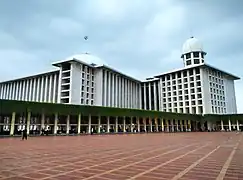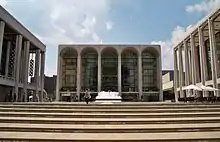New Formalism (architecture)
New Formalism is an architectural style that emerged in the United States during the mid-1950s and flowered in the 1960s. Buildings designed in that style exhibited many Classical elements including "strict symmetrical elevations"[1] building proportion and scale, Classical columns, highly stylized entablatures and colonnades. The style was used primarily for high-profile cultural, high tech, institutional and civic buildings. Edward Durrell Stone's New Delhi American Embassy (1954), which blended the architecture of the east with modern western concepts, is considered to be the symbolic start of New Formalism architecture.[2]

Mark Taper Forum, Los Angeles, designed by Welton Becket and Associates, 1967
.jpg.webp)
The now destroyed original World Trade Center in New York City, designed by Minoru Yamasaki with Emery Roth & Sons associates, 1966
Common features of the New Formalism style include:
- Use of traditionally rich materials such as travertine, marble, and granite or man-made materials that mimic their luxurious qualities
- Buildings usually set on a podium
- Designed to achieve modern monumentality
- Embraces classical precedents, such as arches, colonnades, classical columns and entablatures
- Smooth wall surfaces
- Delicacy of details
- Formal landscape; use of pools, fountains, and a sculpture within a central plaza[2]
Notable architects
Notable examples

Istiqlal Mosque in Jakarta, Indonesia
- McGregor Memorial Conference Center, Detroit, Michigan (1958)
- Pacific Science Center, Seattle, Washington (1962)
- Lincoln Center for the Performing Arts, New York City (1962/69)
- Memphis International Airport, Memphis, Tennessee (1963)
- Uptown Campus, University at Albany, SUNY, Albany, New York (1964)
- 2 Columbus Circle, New York City (1964)
- Dorothy Chandler Pavilion, Los Angeles, California (1964)
- Cambridge Tower, Austin, Texas (1965)
- Old World Trade Center, Lower Manhattan, New York City (1966)
- Ahmanson Theater, Los Angeles, California (1967)
- United States Confluence Theater - now John H. Wood Federal Courthouse, San Antonio, Texas (1968)
- The Forum, Inglewood, California (1967)
- Wilshire Colonnade, Los Angeles, California (1970)
- John F. Kennedy Center for the Performing Arts, Washington, D.C. (1971)
- Teacher Retirement System of Texas Headquarters, Austin, Texas (1973)
- Istiqlal Mosque, Jakarta, Indonesia (1978)
- Weber County Main Library, Ogden, Utah (1968)
Wikimedia Commons has media related to New Formalism (architecture).
References
- Wiffen, Marcus, American Architecture Since 1780: A Guide to the Styles, The M.I.T. Press, Cambridge Massachusetts, 1969
- "Architectural Styles in Fullerton: New Formalism". fullertonheritage.org. Archived from the original on 2017-11-29. Retrieved 2014-12-30.
This article is issued from Wikipedia. The text is licensed under Creative Commons - Attribution - Sharealike. Additional terms may apply for the media files.
